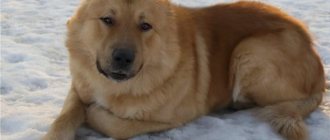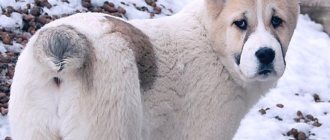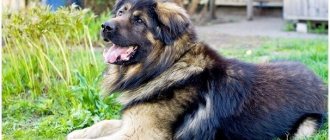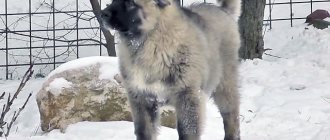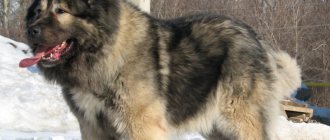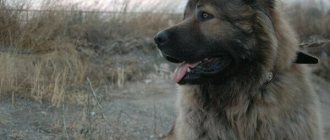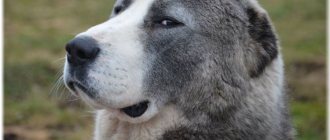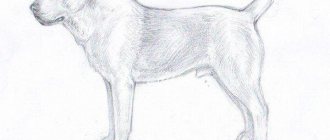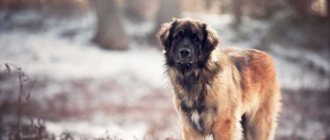Currently, the Alabai is considered one of the most popular guard and security breeds in Russia and the CIS.
However, there are other breeds in the world that are similar to them both in appearance and in origin.
Most of these dogs are wolfhounds or shepherd dogs.
However, Alabai were also originally bred specifically for herding livestock and protecting them from wild predators, and therefore they too can rightfully be considered wolfhounds, despite the fact that they are officially called Central Asian Shepherd Dogs..
History and purpose
Both of these breeds belong to the wolfhound family, which in turn indicates their ancient origin. Central Asia is the homeland of these breeds; they are relatives of the Tibetan Great Danes. Such dogs were necessary for security and protection. At first they looked after flocks of sheep; the shepherds could not afford a large number of dogs and chose the most reliable and best puppies from all. Then they worked on guard duty. They have proven themselves through their fearlessness and endurance. Increasingly, they are being used to protect private territories.
Breeding Caucasian Shepherd Dogs
In the 1960s, the breed was used in East Germany along the Berlin Wall. As a border guard dog.
She became popular as a working dog for the police. As a guard dog throughout Europe and parts of Asia. It is recognized in all these areas and by the FCI, UKC and is part of the AKC Foundation Fund Service.
Places such as the Slovak and Czech Republics, Poland and Hungary have strong breeding programs for it to maintain its popularity.
Attitude towards children
If it is important to you how the dog will treat your family, then the best choice is Central Asia. He will be devoted to both the owner and the family, to protect everyone. Unlike the Caucasian, he only recognizes the owner, but with proper upbringing from a young age, a different outcome is possible. Don't let children wake your dog, this will turn him against family members.
A weak-willed person without the makings of a leader will not be able to cope with a Caucasian Shepherd. In such a relationship, the dog will be the master. Therefore, if you are not confident in yourself, choose alabai, it is more pliable
Care and maintenance
The Caucasian wolfhound is a terrible owner who is truly happy only when he has something to protect. Accordingly, the best home for a pet would be a cottage with a courtyard and land. These shaggy brutals are not sensitive to temperature changes, so they feel quite comfortable in a spacious enclosure. Keeping Caucasian Shepherd dogs on a chain is also quite acceptable, but it should be a light chain up to 2.5 m long.
Moving a “Caucasian” into a city apartment is an extreme sport for a very amateur, practiced only by the most stubborn lovers of the breed. Yes, shaggy guards do not suffer from hyperactivity and do not cause pogroms, but they cannot fully realize their security qualities in such conditions. The difficulties with placing a pet should not be discounted. The Caucasian Shepherd is a large breed and its representatives require plenty of space. It is not enough to provide the dog with a spacious bed and a food bowl; it is also necessary to provide an excellent overview of the room entrusted to it. In addition, when opening the door to each guest, the owner will have to carefully monitor the reaction of his pet: a stranger who has crossed the threshold of private property is enemy No. 1 for shaggy bodyguards.
Hygiene
You don't have to be a cynology guru to understand that long-haired Caucasian Shepherds require more careful care than their short-haired counterparts. The soft hair of shaggy individuals becomes tangled, and in winter it absorbs snow moisture, so long-haired wolfhounds are periodically combed and trimmed (the hair on the legs and paws is shortened). Shepherd dogs are washed as needed, for example, when the animal gets dirty in the mud or has acquired blood-sucking “tenants.” At the same time, it is better not to deny dogs swimming in open waters, especially since they are excellent swimmers.
In spring and summer, “Caucasians” suffer from ear mites, so ear specula need to be inspected and cleaned more often in the warm season. If your pet is shaking its head and scratching its ears, contact your veterinarian to investigate the problem. Perhaps it is not mites that are to blame, but otitis media.
The eyes of Caucasian Shepherds are problem-free, but some individuals have a congenital pathology in the form of a loose eyelid. As a result, an infection from outside gets into the eyes, causing inflammation. You can combat the problem with chamomile decoction or veterinary drops.
“Caucasians” like to chew bones and even wooden boards in their spare time, the remains of which get stuck between their teeth. So buy tweezers in advance, which you will use to free your pet’s jaws from solid particles of food and wood. You can remove plaque, which periodically appears in every dog, with a special brush and veterinary paste.
Ear cropping
Previously, the ears of Caucasian Shepherd dogs were subject to mandatory cropping. The procedure was not carried out for aesthetic purposes. In this way, ancient breeders tried to protect their pets from blood loss, because the longer the ear, the greater the risk of injury to the animal in a fight. Today this requirement has been lifted, but for old times’ sake, most nurseries continue to practice this surgical operation.
The ideal age for ear cropping of a Caucasian wolfhound is the first days of life. On the 5th day after birth, the ear tissue thickens, and working with it becomes more difficult and dangerous, as there is a risk of blood loss. Owners who have purchased a puppy with normal ears, but would like to have them cropped, should wait until the dog is one year old. At this age, the animal is able to tolerate general anesthesia, under which the procedure is usually performed.
Important: do not play the know-it-all doctor and do not try to trim the Caucasian Shepherd’s ears yourself. Each animal has a unique shape, thickness and size of the ear, so only a veterinarian or an experienced breeder can determine the principle of “cutting” for this part of the body.
Walk
Of course, it is necessary to walk “Caucasians”, but spending half a day with them on the street is not at all necessary. Please note that shaggy security guards are not happy with promenades that are too long, since they prefer to save their energy for more serious matters. In crowded places, in veterinary clinics and public transport, a muzzle is required. Dogs do not like this accessory, so it is better to accustom pets to it from puppyhood. To go out into the world, the Caucasian Shepherd will need two leashes: a short one (from 1 to 1.5 m) to keep the animal at the owner’s feet, and a long one for the actual walking.
Rules for walking a Caucasian Shepherd dog
- The dog is taken outside only on a short leash and wearing a muzzle.
- Walking Caucasian Shepherd dogs by children under the age of 14, as well as by persons under the influence of drugs and alcohol, is strictly prohibited.
- If an animal is walking in a private fenced area, passers-by must be notified about this. A suitable sign would be: “Beware, evil dog!”, attached at the entrance to the territory.
Feeding
Compared to representatives of other large breeds, Caucasian Shepherds are small dogs. 35-45 g of natural food or 10-15 g of “drying” per kilogram of animal weight - this is the daily food consumption rate for an adult. Shepherd dogs have a high metabolism, which allows them to “squeeze” the maximum nutrients from a relatively small portion. In addition, their digestive system perfectly absorbs milk, a product that can cause intestinal upset in most dogs. Here, however, it is worth making an explanation: only those individuals who have been accustomed to it are able to digest whole milk. If such food did not appear on the dog’s “table” for several months, and then unexpectedly returned, get ready for diarrhea.
The most important product in the diet of the Caucasian Shepherd is meat, and its coarse varieties: horse meat, lean beef, lamb. By-products and fish (mackerel, horse mackerel) are also not excluded. Animal proteins should be diluted with cereal porridges, as well as fruits and vegetables. Cereals (mainly rice and buckwheat) must be thoroughly boiled, otherwise the dog’s stomach will not be able to handle them. You can prepare cottage cheese for your pet: heat a liter of milk on the stove and when boiling add 4 tbsp. l. calcium chloride. Apple and carrot salads with added butter and banana puree are suitable as vitamin supplements.
Caucasian Shepherd Dogs are not picky when it comes to food and willingly absorb everything that their owner gives them. Experts recommend not accustoming your dog to a particular variety of food and delicacies, since representatives of this breed use energy extremely sparingly and do not always have the opportunity to “burn” extra calories. So if your pet begins to suffer from loss of appetite, do not be alarmed and do not try to force feed him. The dog just decided to have a fasting day, thus getting rid of excess energy reserves.
Nature of the rocks
Each of these breeds can be characterized as strong, hardy and fearless dogs; they are very attached to their owner and unquestioningly follow commands. But still there are differences between them and not small ones.
Central Asian wolfhound
- calm
- restrained
- strict
- stubborn
- decisive
- independent
- important
- self-confident
He subtly senses the owner’s mood and is loyal to other animals in the house. Feels like a master in his territory.
Caucasian Shepherd Dog
- wayward
- independent
- free
- wary of strangers
- devoted
- hot-tempered
- impulsive
Divides his world into “strangers” and “us”. Less sentimental than Alabai, will not lick when meeting. Both breeds can withstand a lack of water and food and adapt to climate changes, when it’s cold at night and hot during the day.
Comparison with Kangal and what it looks like in the photo
Kangals are an ancient breed that have changed only slightly over the centuries.
Around the 13th century, they were already known in the Turkish province of Sivas, where they helped people protect herds from predators, and also hunted lions and onagers.
However, in order to improve the reaction and running speed of Kangals, the blood of Turkish greyhounds was later infused into them. Currently, Kangals are better known by the name they received after their official recognition - Anatolian Shepherd.
The height of Kangals is approximately 71-81 cm at the withers and weighs from 40 to 65 kg . The length of their wedge-shaped head is approximately 40% of the height at the withers.
But the muzzle of Kangals is slightly longer than the cranial part, while in Alabais the length of the muzzle is less than ½ of the total length of the head.
Their physique is proportional and muscular, but at the same time, Kangals look somewhat longer-legged than most other wolfhounds, including Alabai . Their coat is not very long, but it is thick and dense.
NOTE!
The main external difference between the Alabai and the Kangal is that it has a stronger and more powerful physique than the Turkish Shepherd.
Another significant difference is that it is not customary for Kangals to have their tail docked. Their ears, like those of the Alabais, are traditionally cropped in their homeland.
Kangals are distinguished by their stable psyche and calm disposition . They are intelligent, loyal and highly trainable animals. They, like the Alabai, are characterized by some independence and stubbornness. At the same time, they are quite loyal to other animals in the house and to children.
Caucasian Shepherd Dog
The Caucasian and Central Asian Shepherd Dogs are very similar, due to the fact that they were bred in similar conditions and that they have the same original purpose.
Both of these dogs are distinguished by their large stature and powerful build: they have almost the same height (the difference between the minimum sizes according to the standard does not exceed 5 cm) and almost the same weight .
In addition, Alabais and Caucasian Shepherds have equally large, fairly wide and massive heads with strong jaws.
Harsh climatic conditions and frequent fights with wolves strengthened the character of representatives of both of these breeds and developed in them such qualities as endurance, unpretentiousness, adaptability and resistance to many diseases.
By character, both of these dogs are distinguished by a well-developed sense of self-esteem, nobility and some self-will..
The differences lie in the fact that the Alabai is more prone to submission and less likely than the Caucasian Shepherd Dog to show a tendency to dominate. Caucasian Shepherd Dogs are also more vicious, they are more aggressive than Alabais and are more independent.
Representatives of both breeds, as a rule, are quite loyal to other pets . As for the attitude towards children, the Alabai is more tolerant of them than the Caucasian Shepherd Dog.
That is why it is believed that Alabai is still more preferable for living in a home, in a family.
As for the Caucasian Shepherd, it is much better suited for protecting territory.
Externally, Caucasian Shepherd Dogs, due to their long and thick coat, can look somewhat more massive and larger than the Alabai of the same height and build.
Armenian wolfhound
The Armenian Wolfhound, also called the Gampr, is, in fact, not a separate breed, but a variety of the Caucasian Shepherd Dog. Its original purpose was to protect homes and livestock from robbers and wild predators such as wolves.
Like Alabai, Gampras are distinguished by their large height and weight, and their body is slightly stretched in length . The proportions of the head and muzzle of Gampras and Alabais are similar: both dogs have a slightly shortened and moderately wide muzzle with strong, strong jaws.
The character of representatives of both breeds also shows common features: first of all, courage, bravery and independence.
However, unlike the Alabais, who are unconditionally devoted to their owners, Gampras have their own opinions regarding the relationship with the owner . If the dog decides that the owner is ignoring him, he may stop obeying him.
At the same time, gampras are affectionate towards people and need to communicate and interact with them. These dogs love to be considered not just helpers, but members of the family.
Gampras, even before they choose a main owner, are already trying to take care of their owner’s children, just as they do when working in a herd, where they primarily care for defenseless kids and lambs, and not adult goats or sheep, who can stand up for themselves.
Moscow watchdog
Despite the fact that the Moscow Watchdog has dimensions similar to the Alabai (height from 66 cm and weight from 45 kg), in appearance it is much more reminiscent of a St. Bernard.
The most characteristic feature that makes the Moscow Watchdog similar to the Alabai is its strong and muscular build, characteristic of true wolfhounds.
The character of these two breeds also has some similarities: both Alabais and Moscow watchdogs are distinguished by self-confidence, balance and independence . In addition, both of these dogs are fearless and have innate protective and watchdog qualities.
At the same time, the Moscow watchdog is more sociable and, in general, more obedient and friendly towards people than the more reserved and not so sociable Alabai.
The Moscow Watchdog, unlike the Alabai, can be kept not only in the house, but also in the apartment, however, subject to regular training at the training ground and long active walks.
German Shepherd
The German Shepherd has more differences than similarities with the Alabai.
Perhaps the only thing that these breeds have in common is courage, bravery, intelligence and distrust of strangers. The external resemblance of these dogs is weakly expressed, even their body types are completely different . And German Shepherds are smaller in size.
In addition, they have erect ears, and not drooping ones like the Alabai (unless, of course, they were cropped for him as a puppy). The head of a German Shepherd looks like a rather narrow wedge, while the Alabai has a wider skull and a shorter and more voluminous muzzle.
The most characteristic external difference between these two breeds is that the scarlet has a flat back, while the German Shepherd has a clearly defined bevel towards the tail.
By nature , Alabai are more phlegmatic, while German Shepherds, on the contrary, are mostly choleric . These dogs are characterized by mobility, intelligence and excellent learning ability.
Alabais are slower and do not remember new commands as quickly as German shepherds.
German Shepherds get along well with other animals in the house, even cats, and they are also quite patient with children..
Alabai, unlike them, does not like cats, and, in most cases, is indifferent to children.
Tibetan mastiff
The Tibetan Mastiff , considered one of the most likely ancestors of the Alabai, is also distinguished by its large stature and powerful build .
Like the Alabai, they have well-developed protective instincts, a calm disposition and independence. In addition, the Tibetan Mastiff, like the Alabai, also needs a strong and self-confident owner and consistent professional training.
The main external difference from the Alabai in the Tibetan Mastiff is the long and thick straight hair, forming fringes in the form of a lush mane, giving the dog a resemblance to a lion.
By nature, the Tibetan Mastiff is more friendly towards people, as well as other dogs, and shows aggression only when absolutely necessary. He prefers not to conflict with other people's dogs, but if he is hurt, he can easily stand up for himself.
Unlike Alabais, Tibetan mastiffs do not engage in fights with wolves, but, in the event of an attack by predators, bark to warn their owners of danger.
Behavior in a dangerous situation
If we consider the tactics of action when protecting the owner, attacking a stranger, then there are huge differences.
It is against the law for a dog to participate in fighting. This is prohibited in many countries
The Caucasian is a serious guard, he is not afraid even of a knife, he will fight to the end. Quite cunning, he waits and does not scare away the enemy so that he comes closer, then he attacks. During a fight, if a person gives up, he will simply stand over him. If you do not resist and lie down, he will not continue and will wait for the owner. They have the ability to instantly switch to a point that poses danger.
Dog fighting
Both breeds became famous for competing in dog fights. Moreover, both occupy second position in the list of the best, right behind the pit bull.
Dog fighting appeared many centuries ago; even the ancient Romans pitted dogs against each other, as well as against bears, elephants and other large animals for fun. In the 19th century, these fights were called sports, and in the 20th century they began to earn big money from it.
Today, dog fighting is prohibited in 50 countries, and officially permitted in only three. The most brutal battles are held in the United States, and the organizers of these events are persecuted more than anywhere else. Even spectators of underground clubs can go to jail for a long time.
See also: Hachiko: Akita Inu dog breed
Dog fights - Alabai versus Caucasian Shepherd are held quite often and are the most spectacular. All blood lovers gather there. And, if in Europe they want to see who is stronger, then in America the whole point lies in who will win, that is, who will survive. To be fair, it should be noted that in states where dog fighting is legal, a veterinarian is present, and the fighting itself never ends in the death of the animal.
If you are interested in blood sport, train your pet well, take care of it and let it rest after each fight. Some do the opposite - they treat the dog terribly, do not feed it and beat it to provoke aggression. Some of them even inject drugs into their pets to make them stronger and angrier. But you and I are adequate people, aren’t we? Is the health or even the life of your beloved dog worth this “black” money?..
How much does a puppy cost?
average price for both breeds: 10 - 15,000 rubles
- < 10,000 will be a great friend and guard, but without participating in competitions
- from 10,000 to 25,000 the puppy does not have a distinctive build
- from 25,000 to 50,000 you can buy a small puppy with a promising future
If you want to buy a puppy to participate in exhibitions, contact only specialized nurseries.
Please remember that a small puppy is like a child. He needs to be educated, explained what is possible and what is not. Without doing this properly, later behavioral difficulties will arise that cannot be changed.
Who is stronger?
Large, powerful dogs with similar characteristics are attracted not only for security activities. They are often forced to take part in dog fights. The confrontation between a Caucasian and an Asian is considered the most unpredictable, since it is difficult to predict in advance who will be stronger.
Both dogs have the same benefits.
- The Caucasian wolfhound is fearless, aggressive, lightning fast, and smart.
- The Central Asian wolfhound is decisive, brave, fast, rational.
The Caucasian is the first to enter the fight. It is easier to anger him and set him on the enemy. In the heat of battle, he quickly loses his head and acts more instinctively than deliberately.
Alabai strives to win the battle in order to gain the approval of his master. He thinks through his actions. His main tactic is to harass the enemy with constant attacks, and then show an iron grip.
Which breed do you like best?
Education and training
The main thing in training a Central Asian Shepherd is the psychological moment of establishing contact with the dog.
It is important to constantly maintain a leadership position. Despite its independent and proud character, the breed has a pronounced subordination and trust to the leader of the pack.
Alabai is a dog-soldier waiting for orders from the commander. But abusing the dog’s trust and violating his dignity is dangerous. This is fraught with loss of contact with the pet and subsequent disobedience, and sometimes even attempts on the part of the dog to occupy the highest level in the hierarchy of the pack.
First, from 3 to 5 months, the puppy is taught basic skills: name, commands “sit”, “lie down”, “place”, “come to me”, “no”, etc. Alabai is more problematic to train than many service breeds, for example, a German shepherd, but remembers the lessons learned all his life.
If you want to raise a really good dog, then you need to seek help from a qualified trainer. At a minimum, puppy training can be done under the guidance of an experienced instructor. This is especially true if you have no previous experience of keeping such a breed. If, out of ignorance, you make any mistakes in upbringing, it will be impossible to correct them in the future. Improper upbringing is a guaranteed lot of troubles in the future: the dog will ignore your commands and may attack people, including family members. Alabai is too dangerous a breed to let the educational process take its course.
Features of the Caucasian and Alabai
Connoisseurs of large dog breeds often face a choice: who is better - an Alabai, a Caucasian or a mestizo, that is, a cross between these breeds? In fact, the difference between these dogs is not so great, and mainly it lies not so much in physical characteristics, but in character traits.
Alabai is a very powerful and angry dog
Who is bigger: Alabai or Caucasian
Alabais are considered larger animals. The average height of a male reaches 78 cm, and he weighs 80 kg. While the average height of a Caucasian is up to 75 cm, and a representative of the breed weighs about 75 kg. The characteristics given apply to males. But females differ in approximately the same height of 65-69 cm (for each breed). But at the same time, Alabai girls weigh less, on average about 50 kg.
Of course, in each specific case everything depends solely on the data of the dog itself and on what form it is in.
Caucasian Shepherd Dog
How are they similar?
Whether it is a Caucasian, an Alabai or a mixture of these breeds, their main traits are devotion to the owner and fearlessness. These dogs were bred primarily as watchdogs, which affected their character, behavior, and appearance.
For your information! These are large animals, serious, brave, endowed with high intelligence.
How active is the Caucasian Shepherd?
This is such a big dog that it is, of course, not adapted to apartment life; it needs a large house where it has room to move and at least a large yard.
The Caucasian is not very physically active, but he does require a certain level of exercise to keep him healthy, and he is surprisingly agile for his size when needed.
He also needs a lot of mental stimulation. He should get one or two long walks a day, some off-leash time somewhere safe where he can be tied, and training will need to include strict leash walking rules to ensure he never pulls on you.
Popular Alabaev colors
Sheepdogs are famous for their very coarse coat with a thick undercoat. On the neck, the hair forms a rather massive mane, feathering on the back of the paws, tail, and behind the ears. Hard wool and thick skin protects the alabai from enemy bites and low temperatures. The tail is set high, quite thick at the base. Before docking, it always has the shape of a sickle, sometimes it can be rolled into a ring.
There are two types of coat in Central Asian Shepherds:
- Long coat about 7-8 cm;
- Short 3-4 cm;
- Smooth.
The Central Asian Shepherd dog comes in a variety of colors, including black and white, brindle, red, speckled, piebald, and gray. All color options are allowed, except for a mixture of brown and gray, chocolate, and blue. In different countries, one or another color of Central Asian Shepherd Dogs is popular.
The eyes of Alabais are widely spaced, medium in size, oval in shape. The color varies from light to dark brown depending on the coat color. The eyelids are always black. The large nose is most often black, but in fawn and white dogs it can be light. It is desirable that the upper lips, which completely cover the lower jaw, also have black pigmentation. The color of the claws can be any.
Main differences
This table provides a comparison of the Caucasian Shepherd and Alabai.
| External indicators | Caucasian Shepherd Dog | Alabai |
| Head | The largest, widest part is in the cheekbone area | Proportional |
| Eyes | Small eyes, deep set | Wide apart |
| Ears | Set on high | Low set |
| Muzzle shape | Square | Rectangular |
| Coat type | Straight hair and thick undercoat | Thick coat, can be long or short |
| Limbs | Short | Middle length |
| Tail | Twisted into a ring, fluffy | Often docked, so it is short |
The Caucasian Shepherd Dog is smaller in height: the Alabai grows up to 70-80 cm, and the Caucasian - 60 cm. But it all depends on the feeding habits and living conditions.
Alabai is more than Caucasian
Caring for the Caucasian Shepherd.
Care needs of a Caucasian.
The short-haired type needs a little less brushing than the long-haired type, simply because the latter can easily become tangled without much attention.
Given his size, the long coat will take some time to brush completely. He does shed a lot so there will be a lot of hair around the house.
Bathing a dog this size is no easy task, so leave it until he really needs it. If you don't have an indoor room, you can use a hose in the yard if the water is warm. Or sign up for a local professional dog grooming salon.
The problem with the latter option may be that he does not tend to get along with other dogs, so you will have to find a time when there are no other dogs in the salon.
Cleaning the teeth and ears of a Caucasian Shepherd.
Other needs include brushing the teeth with canine toothpaste and a toothbrush at least two to three times a week, checking the ears for infection and wiping them with a clean dog ear cleaning solution, and trimming nails when they become too long.
The latter must be done carefully so as not to cause bleeding and pain, and do not cut the nail plate where the blood vessels and nerves are located.
Feeding the Caucasian Shepherd.
This dog will eat 6 to 14 cups of dry food per day, divided into at least two meals or even 3 to avoid problems with bloating.
The effect on the amount of food consumed depends on its size, health, metabolic rate, activity level and age. Make sure your Caucasian also has access to enough water - it should be changed frequently and always fresh.
Caucasian Shepherd in our time
The Caucasian Shepherd is a giant breed weighing between 45 and 100 kilograms and a height of 65 to 75 centimeters.
This is a fearsome, muscular and powerful looking breed, there are several types, some of which can be even larger and stronger, and some that can lean towards massive and strong bones.
This difference is often observed between dogs in mountainous areas and dogs in lowland areas. The coat is also different, with the latter having a shorter coat and the former having a longer and thicker coat.
Wool is weather resistant, and when it is younger, the fur becomes thinner. Colors can range from grey, brindle, pied, fawn, brown and white, brown is not allowed for FCI show dogs.
This dog has a tail covered with long, fluffy hair, and hips that are slightly raised from the topline. His front legs are straight and long, and his hind legs are powerful.
Its paws are heavy, very large and have protection from the cold in the form of fur between the toes. His eyes are somewhat deep-set and dark. The nose is large, with wide open nostrils, black. In some areas of its native region the ears are short. They are also well covered with fur to protect them from the cold.
Comparison of breeds by other criteria
Since these breeds are also herding breeds, they stand out among the rest with their intelligence and intelligence. Because security work requires an adequate assessment of what is happening. These dogs are very brave and can act independently. Caucasians love freedom, and that is why it will be difficult for them to obey the owner, but the Alabai will look forward to attention and approval. The Central Asian Shepherd is cunning and flexible, also gets along well with children and can become a “nanny” for them.
For whom is outdoor living suitable?
For any large breed, including the Caucasian Shepherd, it will be more comfortable in a private house with a large plot than in a small apartment. Since this dog loves freedom, it needs constant physical activity. This breed is perfect for the role of a guard. But the dogs’ loyalty and devotion to their owners will need to be earned.
Central Asian Shepherds are one of the best guards; they will serve the family faithfully. Relationships should be built on respect. But since shepherd dogs love freedom, they cannot sit on a chain; they evaluate it as humiliation, because they cannot move freely, and this negatively affects their morale.
The best option would be a spacious enclosure with a house. Thanks to their fur, dogs can easily tolerate any temperature conditions.
How to feed?
Caucasian Shepherds can eat anything. You can feed dogs dry and wet food. An adult dog must be fed meat (up to 1 kg per day), boiled chicken, fish and vegetables. There should also be cereals: rice, buckwheat, oatmeal, wheat and pasta. Eating fruits and greens is very beneficial for animals, but they cannot be given in large quantities; they must be raw.
Central Asian Shepherds are completely unpretentious in food, but since they may have problems with joints, it is simply necessary that their diet have a high calcium content. This breed must be fed with meat (beef and veal), sea, lean fish, raw or boiled vegetables, and cereals. Chicken should not be included in the diet.
